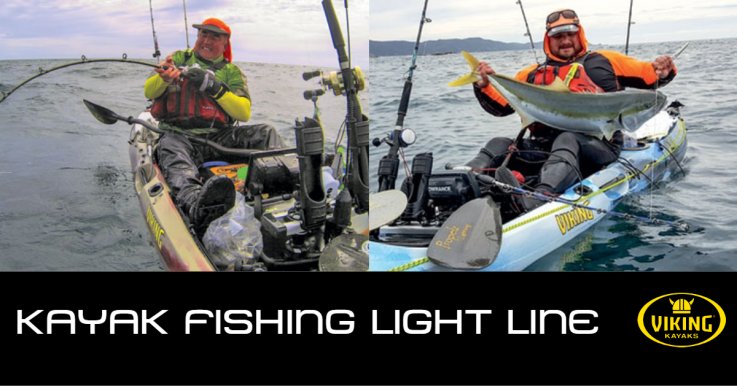Kayak fishing light line techniques
11:58AM 3rd Nov 18

Kayak maestro Stephen Tapp goes back to the future, leaving the anchor at home and dropping to lighter line – and gets his just deserts!
I’m sitting here contemplating a selection of bruises, a burnt thumb the security scanner won’t recognise, and an assorted selection of cuts and scrapes – just the sort of thing you’d expect after being in a brawl!
However, these aren’t the result of some dark carpark escapade, instead the damage was suffered during a session chasing big fish in Northland over a spring weekend. Being seated in a kayak sure puts you close to the action – really close – but the rough and tumble with moochers and hoodlums is definitely fun!
The surprising part is this wasn’t due to grabbing the heavy gear and skull-dragging the fish over the side. Rather, I’d changed down from 37kg to 15kg for jigging, and 15kg to 8kg and lighter on the rest of my tackle. Combine this with the marauding hordes of snapper and kings on the offshore reefs, and the stage was set for beatings at both ends of the stick!
So why the changes to lighter gear? They came about after reviewing the last 12 months of fishing and realising just how few fish had actually managed to make their escape after solid hookups. Getting reefed was rare, and even when dragged through structure, few fish were lost, despite the unnerving sensation of line dragging through kelp and over rocks. On other occasions, when doing battle with big fish in the open, maxing out the drag never resulted in a broken line, with the kayak simply being dragged faster and faster across the water!
Originally, the move to heavier line classes came about during competition fishing. When anchored or drifting under a chute (holding the kayak almost stationery), several fish managed to pull off enough string to wrap me up on structure and gain their freedom. Consequently, braids were changed and fluorocarbon leaders bumped up a couple of line classes.
Over the last 12 months the comps haven’t been as serious, so I’ve reverted to the old habits of snooping around with the sounder, rather than berleying for the big ones. In fact, the only time I anchored was during the Taranaki Kayak Fishing Classic when fishing shallow behind the breakers (primarily so I didn’t get sucked into the smash zone!). With the anchor staying at home and the drift chute only carried as a safety device, I’ve regained one of the most useful fishing features of fishing from kayaks – mobility.
Mobility provides the obvious advantage of being able to snoop quietly around without disturbing our quarry. We can explore in amongst the rocks and structure, move from area to area, and precisely reposition to ensure we’ve properly covered all the fishy possibilities each location offers.
But maintaining a kayak’s mobility has another massive advantage many overlook: our ability to track after a fish once it’s been hooked. This restricts the amount of line run off the reel, reduces line angles that might allow big fish to reach line-busting structure, and means less pressure on the line.
A perfect, if extreme, example of this is the shallow-water jigging Milkey and I have been doing throughout the year, resulting in several kingfish to around 25kg in just 10–12 metres of water. Sometimes the kelp and stones are visible below; any line lost following hook-ups can result in hoodlums gaining their freedom. We must therefore lock up and stay right on top of the fish, as the vertical line generally remains clear as the kings traverse the gutters and reef edges, producing heart-in-the-mouth excitement.

However, as mentioned earlier, this is an extreme example and treads a very fine line between landing the kingfish and joining it for a swim. But it does prove the concept that your kayak can be used to aid your rod and reel when playing big fish. This is something larger craft can’t do anywhere near as effectively.
Fighting with the kayak
The latest Northland session began by my dusting off the lighter rigs. So instead of the big Ocea Jigger and 300g jig rod I’d been enjoying using over recent months, I married my little Saltist 20 reel loaded with 15kg line to a 150g rod. As for baits and soft-baits, I grabbed a couple of the smaller bait-caster outfits and reduced the fluorocarbon leader material by at least one line class.
The plan was to fish depths between 20–30 metres so a bit more margin would be available when fighting kingfish; maxing out in the shallows on 15kg would probably not be enough to keep a 20kg fish off the stones, and a parting line would likely result in a splash over the other side of the kayak upon the pressure suddenly unloading. This depth would also allow us to easily hunt fish with the sounder and target them without a sea anchor.
With the exception of mechanical jigging, the concept is based around targeting fish with descending baits and lures, rather than on retrieval techniques. It generally goes like this: when a school is marked on the sounder, a suitably weighted bait or soft-bait is dropped down via a free-spool reel, with the offering ‘swimming’ to the target while the kayaker gently paddles to stay on station.
Using a free-spool reel rather than a fixed-spool (spinning) is key. The free-spool’s rotating spool unloads line with minimal slack in the system, so the angler stays in touch with the boat or lure. The fixed-spool reel’s line, on the other hand, unloads with a spiralling motion that sees plenty of extra line ‘floating’ around in the process, making it much harder for subtle strikes to be detected and hooks set.
This is how I do it. The rod is laid along the top of my leg so the line just clears my preferred side of the kayak, and the reel placed into free-spool. I then tend to paddle gently to keep the kayak in position and facing the way I want. With the rod lying along my leg, it’s easy to watch the rod tip and line spooling off, and I can also feel any strikes. The moment there’s any hesitation, jerk, or acceleration, I drop the paddle in my lap and strike.
Once hooked up, I then use the kayak as part of the fish-fighting arsenal. With nothing dragging in the water and the hook-up occurring below the kayak, it’s relatively easy to track along after the quarry. This also means the battle’s dynamics change: rather than just using the rod and the reel’s drag to tire large fish, we can track along overhead and simply focus on trying to get its head up. As soon as a little line is gained, it’s possible to ‘short-stroke’ the rod to keep the fish angling up and make serious headway. In fact, I’ve found it’s not unusual to have a confused fish swim towards me – an exciting scenario when the still green fish wakes up to the danger on a short lead!
The only time this system can be harder to manage is when the wind gets up. Presenting baits and lures while staying over the fish is still easy, but once hooked-up, you’ll need to apply enough line pressure to keep the kayak close to the fish. Consequently, a step up from light gear at around 10 knots of wind is usually required. However, if the wind strength continues to increase, it becomes impossible for the kayak to be dragged along by the fish unless heavy gear is used. At this point, reverting to using a sea anchor will be the best option to stop the kayak blowing away from the fish faster than you can recover line.
Fun in the north
This latest session had near-perfect conditions, with the brawls resulting in burnt thumbs, line cuts and an assortment of bruises – so deliciously painful and testament to just how successful this style of kayak fishing can be.

Multiple snapper to around 8kg fell to baits and lures – so many, in fact, it became critical to crush the hooks’ barbs to make releasing easier. Big blue cod pounced on anything that made it to the bottom and the kings came out to play, too!
Being dragged around by a kingfish is the ultimate in fishing from a mobile kayak without anything in the water to slow it down. The two days saw more than a dozen up to around 18kg caught and released on tackle ranging between 8 and 15kg. Always willing fighters, it’s amazing how quickly it’s possible to get them to the kayak on light gear – and that’s where the real brawl begins!






